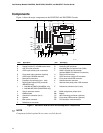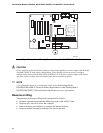Desktop Board Features
19
✏
NOTE
Computer systems that have an unshielded cable attached to a USB port might not meet FCC
Class B requirements even if no device or a low-speed USB device is attached to the cable. Use a
shielded cable that meets the requirements for a full-speed USB device.
PCI Enhanced IDE Interface
The PCI enhanced IDE interface handles the exchange of information between the processor and
peripheral devices like hard disks, CD-ROM drives, and Iomega ZIP
†
drives inside the computer.
The interface supports:
• Up to four IDE devices (such as hard drives)
• ATAPI devices (such as CD-ROM drives)
• PIO Mode 3 and PIO Mode 4 devices
• Ultra DMA (33 MB/sec) and ATA-66/100 protocols
• Support for laser servo (LS-120) drives
Add-in Card Connectors
The D815EEA2 and D815EPEA2 boards have the following ATX-compliant add-in card
connectors:
• Five PCI bus connectors (PCI bus connector 5 slot shared with CNR)
• One AGP universal connector
• One optional CNR connector (slot shared with PCI bus connector 5)
The D815EFV and D815EPFV boards have the following microATX-compliant add-in card
connectors:
• Three PCI bus connectors (PCI bus connector 3 slot shared with CNR)
• One AGP universal connector
• One optional CNR connector (slot shared with PCI bus connector 3)
AGP Universal Connector
The AGP universal connector is a high-performance interface for graphics-intensive applications
such as 3D graphics. AGP is independent of the PCI bus and is intended for use with graphical
display devices. The AGP universal connector supports AGP 1x, 2x, and 4x. The AGP universal
connector also supports the GPA add-in card on D815EEA2 and D815EFV boards.
An AGP card retention mechanism (RM) is included with the boxed desktop board. Installation
instructions are presented in Chapter 2.


















